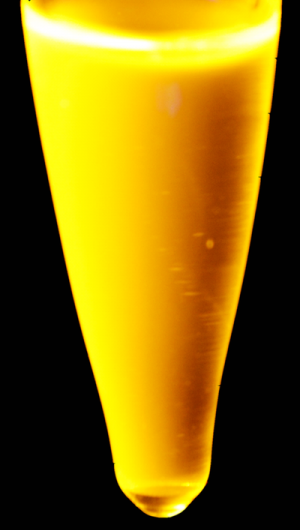July 1, 2013 weblog
Researchers find orange manganese-doped quantum dots made up of many colors

(Phys.org) —A team of researchers working at the Indian Institute of Science in Bangalore has found that manganese-doped quantum dots that appear orange are actually a mixture of many dots of different colors. In their paper published in the journal Physical Review Letters, the team describes how upon microscopic examination of a sample of seemingly orange quantum dots, they discovered a mix of dots of different colors that gave the sample its overall orange hue.
Prior research has found that quantum dots can be created that emit different colors depending on how large they are. Such dots absorb short wavelength photons and emit long wavelength photons. The color of the emitted photon stream depends on the size of the dot because it determines its quantum and energy state. Scientists are studying colored quantum dots because it's thought they might be used to create lighting or display devices. One major drawback to their use, however, is the material used to create them: cadmium-selenide. It's highly toxic. For that reason, researchers have been looking to other materials as a replacement. In this new effort, the researchers created light emitting quantum dots using a zinc-cadmium-sulfur alloy that had been doped with manganese. Prior research with similar materials has resulted in samples that result in emitting just one color—orange.
To learn more about why the dot samples emitted just one color, the researchers spread a single layer of the dots over a polymer film, allowing for a closer look using a microscope. To their surprise, they discovered a rainbow of colors being emitted by the dots. The orange was simply the color that was produced when they were blended. Because quantum dots created via manganese doping are not color dependent on size, the researchers theorized that the different colors they witnessed were the result of where their ions were located on the dots—some were on or near the surface, others were near the center.
To test their theory, the team coated some of the dots with a layer of material that hadn't been doped, preventing ions from residing on the dot surface. In so doing, they discovered the light emitted was bluer than similar dots without the coating. Thus, they showed that their theory was correct while also demonstrating a way to customize the color of the dots they created.
The researchers believe the colored dots have more wide ranging uses than simply in lighting or display devices, suggesting they might wind up in solar cells as well.
More information: Ultranarrow and Widely Tunable Mn2+-Induced Photoluminescence from Single Mn-Doped Nanocrystals of ZnS-CdS Alloys, Phys. Rev. Lett. 110, 267401 (2013). prl.aps.org/abstract/PRL/v110/i26/e267401
Abstract
Extensively studied Mn-doped semiconductor nanocrystals have invariably exhibited photoluminescence over a narrow energy window of width ?150??meV in the orange-red region and a surprisingly large spectral width (?180??meV), contrary to its presumed atomic-like origin. Carrying out emission measurements on individual single nanocrystals and supported by ab initio calculations, we show that Mn PL emission, in fact, can (i) vary over a much wider range (?370??meV) covering the deep green—deep red region and (ii) exhibit widths substantially lower (?60–75??meV) than reported so far, opening newer application possibilities and requiring a fundamental shift in our perception of the emission from Mn-doped semiconductor nanocrystals.
via Physics Focus
Journal information: Physical Review Letters
© 2013 Phys.org



















